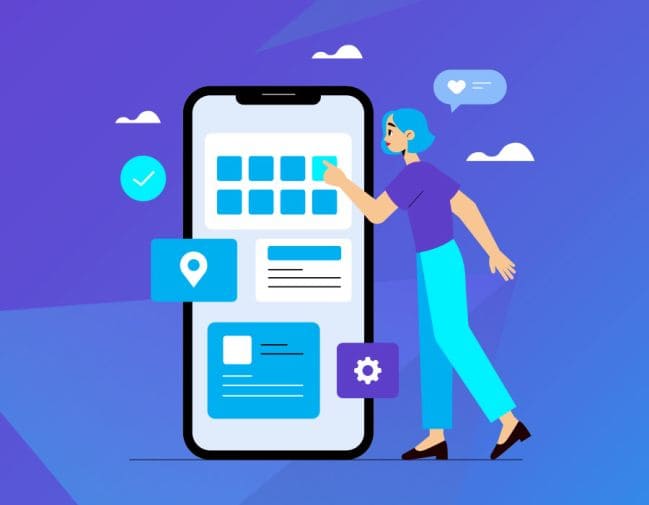Mobile apps are a must-have for APAC, or Asian-Pacific, businesses, but their development costs can break the bank. In fact, slow mobile app development is costing companies millions of dollars. For SMEs with tight budgets, it’s a constant struggle.
Despite this, the mobile app market in APAC is growing rapidly, with installs across all verticals in APAC increasing by 31% YoY in 2020, and continuing to grow steadily in 2021, up by another 4%. This blog cuts through the complexity and reveals proven strategies to optimize mobile app development costs in APAC. Let’s turn your app dream into a budget-friendly reality!
Table of Contents
Understanding Mobile App Development Cost in APAC: How Much Does It Cost?
When it comes to mobile app development costs for the APAC region, your spending can vary significantly depending on various factors such as the complexity of the app, the features required, and the location of the development team. In the APAC region, the average hourly rate for app development is around $30. However, the total cost of developing an app typically falls between USD $30,000 to USD $70,000.
Let’s look at some real-life examples of businesses grappling with these high development costs:
- Slow Mobile Development Costs: Slow mobile app development is costing companies millions of dollars. According to a survey, 75% of respondents said that slow mobile app release cycles are costing their companies at least $100,000 per year, and 13% said it was costing them between $1m and $10m annually.
- There are several challenges that can increase the cost of mobile app development:
- Business Model: The type of business model you choose for your app can significantly impact the development cost. For instance, a simple informational app will cost less compared to an e-commerce app or a social networking app due to the difference in functionalities and features required. In the APAC region, there has been an explosive growth in eCommerce and FinTech app usage. Companies like Grab, Lazada, Paytm, and PhonePe are a few of the big names leading the charge.
- Target Customers: The demographics and preferences of your target customers can also influence the cost. If your target audience prefers sophisticated and feature-rich apps, you might need to invest more in advanced features, user-friendly design, and high-quality graphics. In the majority of APAC countries, people rely on their smartphones to connect with each other, learn what’s happening in the world, and keep themselves entertained.
- Services Used: The services used in the app, such as third-party integrations, payment gateways, location services, push notifications, etc., can add to the complexity and hence the cost of the app. Each of these services requires additional development and integration effort. In the APAC region, Android dominates the mobile platform market. With this constant connectivity and accessibility through Android’s ecosystem, digital media use is more developed in many Asia Pacific markets than in Europe and North America.
These case studies highlight the importance of cost optimization in mobile app development. In the following sections, we will explore various strategies to help APAC businesses navigate these challenges and optimize their cost optimization in mobile app development.
Design Vs. Budget: Factors Influencing Mobile App Development Cost in APAC

In today’s competitive APAC mobile app market, a captivating user experience (UX) is paramount. Users crave intuitive interfaces, sleek design elements, and features that enhance their interactions. However, achieving this design excellence can often clash with another crucial factor: budget.
- App Complexity: As the level of complexity increases, so does the cost. A basic app with standard UI components, simple features, and no backend will cost less than an app with custom UI/UX designs, complex backend, multiple user types, real-time features, etc. The more complex your app is, the more time and resources it will require, leading to higher costs. In APAC, installs and sessions grew by 31% and 54%, respectively from 2019 to 2020 and are continuing impressively in 2021 so far. This indicates that the industry is holding onto users acquired during lockdowns while attracting new ones.
- Features: The number and complexity of features required in the app also play a crucial role in determining the cost. Advanced features like third-party integrations, payment gateways, location services, and push notifications require additional development and integration effort, thereby increasing the cost. A study by GoodFirms also found that the cost to develop an app varies based on the app’s size and complexity. For instance, a simple app development cost ranges from $30,000 to $50,000, whereas an app with medium complexity can cost anywhere from $60,000 to $120,000.
- Chosen Platform: The choice of platform (iOS, Android, or both) can also influence the cost. Developing an app for multiple platforms increases the cost as it requires additional resources and time. A report by Starnavi reveals that in many cases the cost of your iOS or Android development depends on your choice of the place where it’ll actually be built. In general, the average global cost to develop an iOS app is roughly $28,000, while the average investment in developing an Android app is $23,000.
Challenges Unique to Mobile App Development in APAC: Regional Difficulties
The booming mobile app market in the APAC region presents unique opportunities for businesses. However, compared to their Western counterparts, APAC businesses often face distinct challenges when it comes to mobile app development costs. Let’s explore these regional factors that can significantly impact the budget:
- Resource Availability: Limited financial resources in the Developer and QA organizations, inefficient development and QA processes, and a lack of skilled developer and QA labor are driving mobile app update delays. A study reveals that up to 80% of organizations in the APAC region find it difficult to hire and retain talent in critical labor categories such as IT.
- Competition: The APAC region is leading the global mobile app growth index, having three countries i.e., Vietnam, Singapore, and Malaysia in the top 5 fastest-growing markets. With such intense competition, businesses need to invest more in their apps to stand out, thereby increasing the cost.
- Platform Fragmentation: One of the biggest challenges in mobile app development is platform fragmentation. With multiple operating systems, device models, and screen sizes, developers must ensure their app functions seamlessly across different platforms. For example, Android alone has over 2.5 billion active users worldwide, each using different devices with varying specifications.
Outsourcing Mobile App Development for Cost Optimization: Pros and Cons
Outsourcing mobile app development has become a prevalent choice for businesses across various industries, especially in the APAC region. This practice not only aligns with the global need for digital transformation but also caters to specific requirements and quality control.
Pros:
- Access to a Wider Talent Pool: Outsourcing offers businesses access to a diversified and specialized talent pool. With software outsourcing, the limitation of geography no longer constrains innovation and creativity. A report by Zoolatech states that outsourcing enables you to address skill shortages in your region and tap into a readily available global talent pool.
- Potentially Lower Costs: One of the primary reasons businesses hire skilled developers from outside is that their app development costs are lower when they outsource. Getting work done in countries where labor costs are low can save money without reducing quality. For instance, the monthly average salary of a mobile app developer in Mexico is around $1,819 (32,800 MXN), Singapore is around SGD $5,000 per month, while it’s nearly $7,710 in the US.
- Faster Time to Market: Trusted outsourcing firms come equipped with seasoned app developers and well-established workflows. This enables them to start projects swiftly, cutting down onboarding, training, and development time. It also allows employers to monitor progress more efficiently and make informed strategic decisions.
Cons:
While outsourcing can bring numerous benefits to your company, it’s not without its flaws. Here are some potential challenges:
- Communication Challenges: According to a report by Solazu, many professionals in the region may not have English as their first language, leading to potential communication breakdowns, misunderstandings, and delays. Additionally, the APAC region spans several time zones, making it challenging to coordinate and find a mutually convenient time for all parties involved in the project. This can result in delays, missed deadlines, and a breakdown in communication.
- Quality Control Concerns: Ensuring quality can be challenging when outsourcing software development to APAC companies. Businesses may not have the same level of control over the development process as they would with in-house staff. A study by HQSoftware found that in 30% of cases, projects that were outsourced fell short of the client’s expectations due to poor communication with the outsourcing provider. Miscommunication can lead to errors and quality issues, as the vendor may end up delivering a solution that doesn’t meet the client’s goals and requirements.
Mobile App Budgeting for Success:

Budgeting is a crucial aspect of mobile app development. It’s not just about estimating costs; it’s about strategic planning and resource allocation.
According to a report by Goodfirms, the cost of mobile app development can vary greatly depending on the complexity of the app and the location of the developers. Here are some average costs based on an hourly rate of $65:
- Simple App: A simple app with basic user features like signup, login, user profile update, basic dashboard, file uploading, search bar, and basic messaging capabilities costs anywhere from $25,000 to $60,000 and takes around 5 to 11 weeks to develop.
- Complex App: A complex app includes all the basic user features plus app monetization and user engagement upgrades like activity feeds, social media integrations, e-commerce and affiliation, payment gateway, media streaming (audio/video), etc. This type of app costs anywhere from $35,000 to $85,000 and takes around 7 to 16 weeks to develop.
- Advanced App: An advanced app includes the latest technology features like multi-language support, advanced messaging features, augmented reality, machine learning (e.g., chatbox), etc. This type of app costs anywhere from $60,000 to $140,000 and takes around 11 to 26 weeks to develop.
Given the propensity for costs to quickly escalate during app development, the importance of budgeting cannot be overstated. Let’s delve into why this is so crucial:
- Aligning Goals and Resources: Budgeting helps in defining the app’s objectives and aligning them with the available resources. This includes identifying the app’s core functionalities, target audience, and the problems it will solve.
- Effective Resource Allocation: Through budgeting, resources can be allocated effectively among various aspects like development, design, marketing, and maintenance.
- Cost Control: A well-defined budget helps in controlling costs and prevents overspending. It provides a clear picture of where the money is going and helps in making informed decisions.
- Risk Management: Budgeting helps in identifying potential risks and preparing for them. For instance, setting aside a contingency fund for unexpected expenses or changes in scope.
However, budgeting in mobile app development comes with its own set of challenges:
- Unforeseen Features: During the development process, new features might be identified that were not part of the initial plan. These can lead to increased costs and delays.
- Scope Creep: Scope creep refers to unplanned and uncontrolled changes in the requirements, features, or functionalities of a mobile app project. It can cause delays, cost overruns, and quality issues.
- Platform Fragmentation: With multiple operating systems, device models, and screen sizes, developers must ensure their app functions seamlessly across different platforms. Adapting the app’s code, user interface, and features to fit each platform’s requirements can be time-consuming and resource-intensive.
- User Interface and User Experience (UI/UX) Design: Creating an intuitive and visually appealing user interface is crucial for the success of a mobile app. Designing interfaces that cater to various user preferences, screen sizes, and accessibility requirements can be a complex challenge.
Effective Budgeting Tips For Mobile App Development:

Budgeting is a critical aspect of mobile app development, especially for business owners, project managers, and finance managers. Here are some practical tips for effective budgeting:
- Define Clear Project Scope: Clearly defining the project scope helps in understanding the overall requirements, goals, and deliverables of the project. This includes identifying the app’s core functionalities, target audience, and the problems it will solve. A well-defined scope can help in avoiding scope creep and managing changes effectively.
- Start by conducting a thorough analysis of your business needs and goals. Identify the core functionalities that your app needs to have and the problems it will solve. Document these details in a project scope statement, which should include the project’s objectives, deliverables, milestones, and timeline. Regularly review and update the project scope to manage changes effectively.
- Utilize Cost Estimation Tools: Use online calculators, industry benchmarks, or historical data to estimate the hours and rates of your development team. This can provide a more accurate picture of the potential costs involved in the project.
- Use online calculators, industry benchmarks, or historical data to estimate the hours and rates of your development team. This can provide a more accurate picture of the potential costs involved in the project. Regularly review and update your estimates to reflect changes in scope or resources.
- Prioritize Features: Create a Minimum Viable Product (MVP) with essential features to launch quickly. You avoid spending resources on features that may not be necessary or valuable to your users. Additional features can be added in subsequent updates based on user feedback and budget availability.
- Identify the essential features that your app needs to have to provide value to your users. Focus on developing these features first to launch your app quickly. You can then gather user feedback and add additional features in subsequent updates based on user feedback and budget availability.
- Allocate Resources for Testing and Quality Assurance: Addressing issues early in the process can save costs down the line. Iterative testing reduces mobile app development costs by detecting bugs early, gathering feedback throughout the process, and improving quality assurance9. This helps reduce costs by solving problems promptly, mitigating the reputational impact it might have on your brand as well as the negative experience it might deliver to your users.
- Allocate a portion of your budget for rigorous testing and quality assurance. Implement a testing strategy that includes unit testing, integration testing, system testing, and user acceptance testing. Use automated testing tools to increase efficiency and reduce costs.
- Plan for Post-Launch Support: Lean Development is one of the development methodologies for mobile apps. It inherently supports the idea of planning for post-launch support. Its principle of continuous improvement emphasizes the need for ongoing maintenance and regular updates after the app is launched. Furthermore, its iterative nature allows for the incorporation of user feedback into subsequent updates, ensuring the app continues to meet user needs and expectations.
- Plan for ongoing maintenance, updates, and customer support by setting aside a portion of your budget for post-launch support. This includes ongoing maintenance, updates, and customer support. Regularly review and update your app to fix bugs, improve performance, and add new features based on user feedback.
Conclusion:
Mobile app development can be a costly endeavor, particularly in the Asia-Pacific (APAC) region. Various factors influence these costs, including the complexity of the app, the number of platforms it supports, the location of the development team, and post-launch support and maintenance.
However, with strategic planning and effective budgeting, these costs can be optimized. Key strategies include defining a clear project scope, utilizing cost estimation tools, prioritizing features to create a Minimum Viable Product (MVP), allocating resources for testing and quality assurance, and planning for post-launch support. These strategies not only help control costs but also ensure the delivery of a high-quality app that meets user needs and expectations.
At this point, you might be wondering who can help you implement these cost-optimization strategies. That’s where Vinova comes in. As a leading IT company with expertise in mobile app development, Vinova understands the cost of developing your mobile apps, and we have a proven track record of delivering cost-effective solutions without compromising on quality. Our team of experts understands the unique challenges of the APAC market and is committed to helping businesses succeed in this dynamic and competitive landscape.
If you’re ready to start your mobile app development journey and want to ensure cost-effectiveness, don’t hesitate to contact us. Let Vinova be your trusted partner in optimizing mobile app development costs for your APAC business.